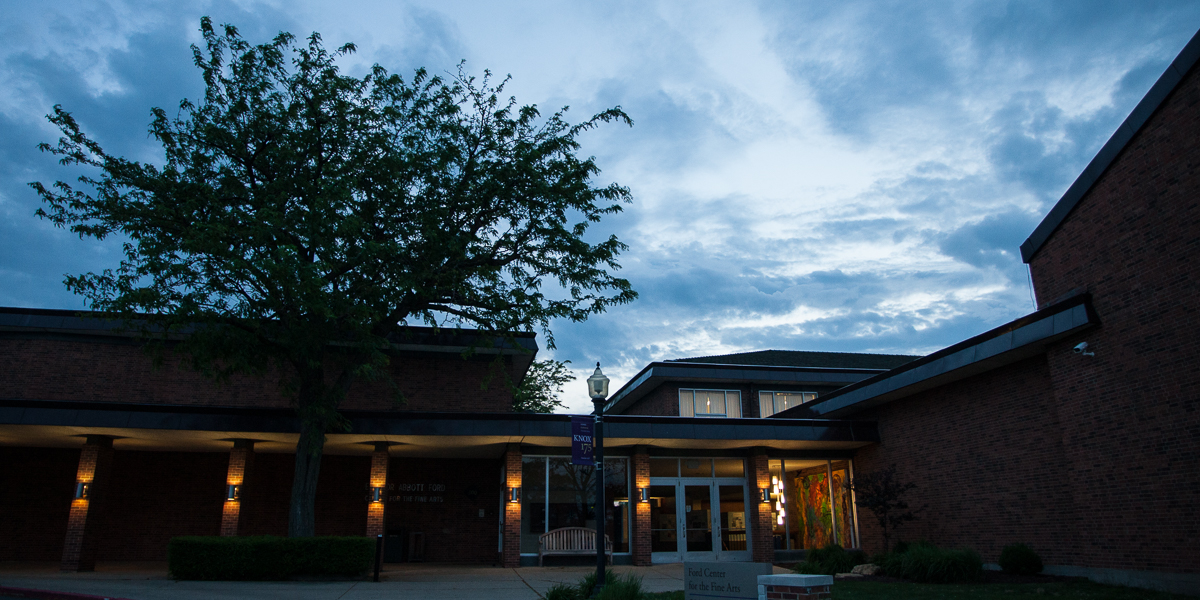

Venture Boldly

By Kylee Norville, Class of 2012
GALESBURG -- Former Maytag employees say what they miss most about their jobs at the Galesburg Refrigeration Plant is the camaraderie they had with fellow co-workers.
And while they also miss the steady income and health benefits, according to the Maytag in Transition Survey, the sense of community they once had is perhaps one of the deepest losses of all.
"A community is people working together and helping each other out when they need it and being there to listen. There's always someone to talk to. And that's just the way it was at Maytag," said 72-year-old Toni Hallowell, who started working at Maytag when she was 26 and completed 40 years there. "If somebody in a department had a problem we all had that problem and we all tried to solve it."
A tight, multi-generational community, almost a family, had formed inside the plant. While the survey looked only at the last group to leave, this family community had existed for years, the loss progressively magnified as the waves of layoffs occurred during the final two years.
|
The Maytag Project During 2010, Knox College professors and students conducted a survey of workers displaced by the closing of the Maytag plant in Galesburg in 2004, hoping to find out how the workers fared after the closure. The survey covered a wide variety of topics, including personal economics, education, current employment, and life satisfaction. In 2011, the Galesburg Register-Mail published survey results, along with in-depth analysis and personal profiles of selected workers written by Knox students and edited by Marilyn Webb, Distinguished Professor of Journalism. The Maytag Project welcomes responses from former Maytag employees who have not filled out a survey. Links to a survey form and all the stories are on the Maytag Project home page. |
A family of thousands
Hallowell said the Maytag community wasn't limited by department. "There were plant-wide collections and functions to help everyone out," she said. "We socialized while we worked."
John Eskridge, 50, started at Maytag in 1989. At the same time, he was part owner of a downtown store until 2001 and he also worked as an auctioneer. It was in this capacity that he helped with many of the Maytag community functions and collections.
"I'd do benefit auctions for people," Eskridge said. "Employees would go to stores and restaurants and things in town and get donations, or they'd have bake sales and 50/50 raffles. They'd have plant-wide collections, too. There were a few thousand people working there; if everyone gave just a little bit, they'd end up with a lot of money. It made it so that whoever needed the help didn't feel so alone. It's hard to take on something like a house fire or a serious illness in the family all on your own."
These were just a few of the many ways Maytag employees gave back to one another and to the Galesburg community. The Maytag corporation itself donated money to local businesses, had open houses which included plant tours and refreshments, and at Christmastime employees would raise thousands of dollars to go shopping for children in need.
"There were always big projects going on," Eskridge said. "They were happening all the time, year-round."
Hallowell and Eskridge both mentioned the many potlucks and department get-togethers as well as the every other year big picnic. These were times for everyone to get together and bring food.
During the Christmas potluck they'd usually stop the line early so everyone could eat together.
The picnic was held at Lake Storey in the pavilions. According to Eskridge, there were usually 8,000 to 10,000 people in attendance. The picnic included an all-you-could eat buffet, fountain drinks, and Schwan's ice cream trucks full of frozen confections for dessert. Prizes, cash, washers, dryers and TVs were given away.
"We all put our time cards in a big barrel and they'd draw names," Eskridge said.
A family affair
Like many other employees, Hallowell had family members who also worked at Maytag over the years. Her aunt and her brother-in-law were both there for 30 years. Two sons worked for a year, and two daughters on summer employment while attending college. However, that wasn't the only family she felt during her time at Maytag.
"I believe I was number two on the seniority list at Maytag when I left," Hallowell said. "Everyone who worked with you had been around for so many years they were like your own family. Almost everyone walked by and smiled and spoke, even if they didn't know your name. There were several people I was very close to. We used to have bonfires and wiener roasts and threw Christmas parties and exchanged gifts. There were closer knit groups that exchanged but we also got others just thinking of you gifts."
On the day they announced Maytag's closing in 2002, the community was confused. "They told us not long after we had gotten the high rating," Hallowell explained. Maytag was rated in Consumer Report for having the number one model of refrigerator in the country in 1999.
"They told us we could hold our stations but not to take out our tools yet. We all thought, ‘Oh, maybe we're taking a pay cut or paying more for insurance.' Then they just came out and told us we'd be closing in two years and paid us for the day and told us we could go home. None of us could understand," Hallowell explained. Even though they could go home that day, a lot of workers stayed and hung around together and talked in the cafeteria.
The end of the line
Hallowell so enjoyed her time at Maytag that she said she worked past retirement. On the day the plant shut down, in September 2004, she retired as an inspector of repair. Everyone got finished that day at different times, she remembered.
"As the product came down the line and the last cabinet came by you, you were done. They were taking apart each department as the last product went down the line." As soon as she checked the last cabinet, her time at Maytag was over and her department was already being dissembled.
"Some people couldn't wait to get out because they were so upset," she said. "Some stayed and waited around because who knew when you'd get to see these people again and some just walked around the plant."
When looking at Maytag from the employees' perspectives and studying the results from the surveys (which included workers who were employed at Maytag from five to more than 30 or 40 years), it is clear that the former Galesburg Maytag plant was its own community.
"Maytag was like a world within a world," said 46-year-old Deb Pendergast, now a Licensed Practical Nurse (LPN). She started at Maytag when she was 20 years old and worked there for 20 years. She had a grandfather, brother, uncles, aunts, and cousins work at Maytag and her mom retired there.
"You can't understand Maytag unless you worked at Maytag," she said. "What happened at Maytag stayed at Maytag. There were things that stayed there and we never took home. If the walls of Maytag could talk, you'd hear some stories."
According to Pendergast, you not only did your job, but you also got to know the people you worked with and their families too. "You knew who was sick and who was well," she said. "You got to know everyone inside out. It was like one big family. There was always some bickering or some camaraderie.
"We depended on each other's joking and camaraderie," she said. "Whatever it took to get us through those eight or 10 hours that we worked, that was what we did. We joked every day; we had to just to get us through. Everything, whether it was serious or not, eventually became a joke or a laugh. That's what got us through the hard times. We did what we had to do to get our paychecks every week."
It's a loss
According to the survey results, a majority of respondents greatly miss that sense of community.
When asked how former Maytag workers identified with their work at Maytag, 82 percent of those who responded answered that they strongly identified with their co-workers and that they were almost like family. Similarly, 85 percent of respondents said that they really miss or miss their former co-workers. Only 12 percent said they hardly miss former co-workers and a mere 2 percent said they didn't miss their former co-workers at all.
In a separate question, when asked to write in what people miss most about Maytag, 66 percent wrote answers that included their co-workers. They used words and phrases such as: "friends, Maytag family, work family, social network, sense of belonging, people -- they were like family, everyone cared about each other and it was like its own community" when answering.
Some former Maytag employees stay in contact and do get together.
"I'll get the occasional phone call or make occasional phone calls to others," Hallowell said. "An ex-foreman lives across the street from me. We were friends then and we are still really close friends. He works out of state even though he lives here. I talk to Tony and Linda Terpening all the time and we all just went out to dinner last week when he was in town."
Pendergast keeps in close contact with five or six people through the phone or Facebook, and Christmas cards or going out to lunch occasionally. "It's not like when we used to see each other every day like we used to. Usually we are playing catch up."
Working as an LPN, she sees former co-workers come into the office. "It's always ‘how's so-and-so, have you seen so-and-so?' I know some are doing other careers, some went to John Deere, some are working with the railroad, but sometimes I'll look at pictures or see names and wonder what ever happened to them. I wish I could get a hold of more of them and kind of see what they're doing. Some people moved and even moved out of state and I have no contact with them."
Groups of former Maytag workers can be seen on a monthly basis gathering at local restaurants to keep in contact and reminisce about days passed.
There are groups on Facebook attempting to re-connect or keep former Maytag co-workers in contact with one another, no matter where they may have ended up since or what they are doing now after the closing. Posts include anything from organizing reunions, venting about the closing, searching for another co-worker, networking to find new jobs, or informing the others about a new diet that they tried and got great results from, or about the passing of a mutual former Maytag co-worker.
Hallowell also mentioned that there is a sort of networking when a former Maytag employee passes away. "I'll get a phone call or I'll call someone else. A lot of the deaths have been shocking. When I open up the paper that's the first thing I look for -- deaths -- hoping there isn't anyone in there. A lot of those that didn't get a career or a job after Maytag just kind of gave up."
Pendergast said the closing was a life changing experience.
"We all kind of knew when Maytag left (the community) was going to end because we didn't know what our future held. Were we going to see each other again? Or work together again? We didn't know," she said. "Like I said before, what happens at Maytag stays at Maytag. If the walls of Maytag could talk, you'd be hearing some stories, that's for sure."
Additional reporting by Ryan Sweikert, Rich Stout and Marilyn Webb.
Published on March 14, 2011